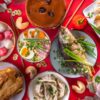Mango Tree’s Chiang Mai menu will be available starting October 15.
Thailand has four major regions—the north, northeast, central, and south. Each region has its own unique cuisine that infuses a balance of sweet, sour, spicy, and salty flavors in each dish.
Northern Thai cuisine is especially known for its use of aromatic ingredients and bold flavors including the use of fermented ingredients and dry heat cooking methods.



Mango Tree’s Chiang Mai dishes are inspired by a recent trip the chefs took to Thailand. The chefs of both Mango Tree Philippines and Mango Tree global teams were invited to learn about Northern Thailand culture and cuisine by immersing with the locals and exploring traditional cuisine with Northern Hill tribes.
They did this with culinary masters Chef Kannika Tassanaprasit, an Iron Chef Thailand challenger, and Chef Phanuphon “Black” Bulsuwan.


The result is a menu that showcases Chiang Mai’s unique flavors and culinary traditions including Miang Kham, Nam Prik Noom, Chiang Mai Laarb Khua, Sai Oua, Hill Tribe Aeb Pla, Kaeng Hang Le, and Khao Soi.









The Mango Tree brand was introduced to the Philippines in 2010 and currently has nine stores nationwide including Mango Tree and Mango Tree Cafe. The first Mango Tree opened in 1994 at Surawong, Bangkok and has over 70 locations in Thailand, Japan, Philippines, Vietnam, Hong Kong, Singapore, China, United Arab Emirates, and United Kingdom.
The Chiang Mai selections will be available starting October 15 with dishes exclusive to Mango Tree and Mango Tree Cafe stores in the Philippines.




